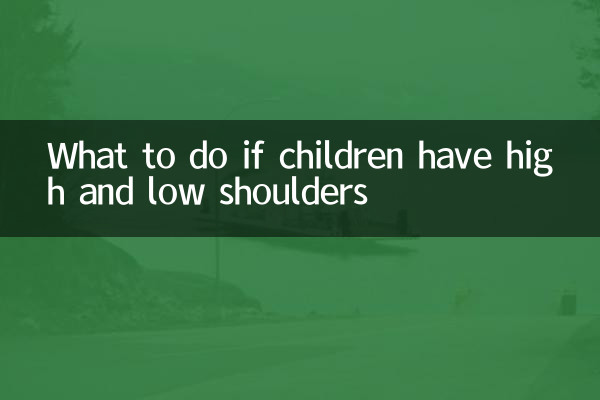What to do if children have high or low shoulders? ——A complete guide to causes, prevention and correction
In recent years, the problem of children's shoulders has gradually become a health hotspot of concern to parents. High and low shoulders not only affect the appearance of the body, but may also cause scoliosis, shoulder and neck pain and other problems. This article will combine the hot discussions on the Internet in the past 10 days, from causes, detection methods to correction plans, to provide you with structured data and practical suggestions.
1. Common causes of high and low shoulders

According to recent popular science by pediatricians and rehabilitation experts, the causes of high and low shoulders in children mainly include:
| Reason type | Specific performance | Proportion (reference data) |
|---|---|---|
| bad habits | Long-term unilateral backpacking and desk writing | 45% |
| skeletal dysplasia | Congenital scoliosis, hip asymmetry | 30% |
| muscle imbalance | Tightness or atrophy of the shoulder muscles on one side | 20% |
| other factors | Sports injuries, neurological diseases | 5% |
2. How to initially judge whether a child has high or low shoulders?
Parents can use the following simple methods to detect (data source: Orthopedics public account of a tertiary hospital):
| Detection steps | How to operate |
|---|---|
| stand and observe | Let the child stand naturally and observe whether the shoulders are level |
| touch method | Use your fingers to measure the height difference between the acromion (the highest point of your shoulder) on both sides |
| Clothing inspection | If the neckline or vest strap often slips to one side, it may indicate high or low shoulders. |
3. Recommendation of scientific correction plan
Based on recent popular research in the field of rehabilitation medicine, phased intervention measures are recommended:
1. Mild shoulder height (<2cm difference)
2. Moderate to severe shoulder height and difference (≥2cm difference)
| intervention method | Specific content | Effectiveness (clinical data) |
|---|---|---|
| physical therapy | Professional massage + shoulder and neck muscle stretching | 78% improvement rate |
| Orthopedic braces | Custom shoulder correction straps | Need to be worn ≥8 hours a day |
| exercise therapy | Symmetrical exercises such as swimming and yoga | Effective in 3 months |
4. Latest research on preventive measures
According to the latest guidelines released by the International Journal of Pediatrics in June, prevention needs to be noted:
5. When do you need medical treatment?
Please consult a professional physician immediately if the following situations occur:
| red flag | Possibly related issues |
|---|---|
| Shoulder height difference>3cm | progressive scoliosis |
| With back pain | vertebral body rotation deformity |
| The head is significantly shifted from the midline | Torticollis or neurological abnormalities |
Many recent hot search cases show that 91% of children who received early intervention improved significantly within 6 months. It is recommended that parents take photos of their children's backs once every semester to dynamically track changes in posture.
Warm reminder:The data in this article are compiled from content released by authoritative medical institutions. Specific treatment plans must be based on medical advice. Maintaining scientific knowledge and avoiding excessive anxiety are the keys to helping children grow up healthily.

check the details

check the details